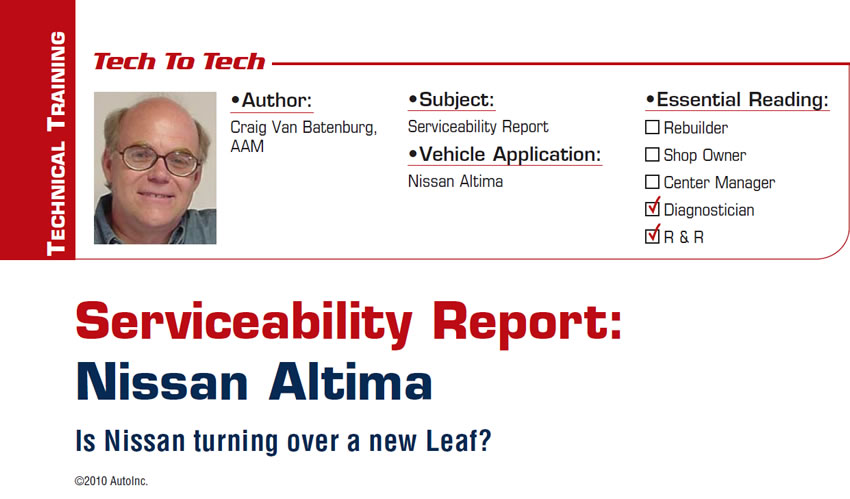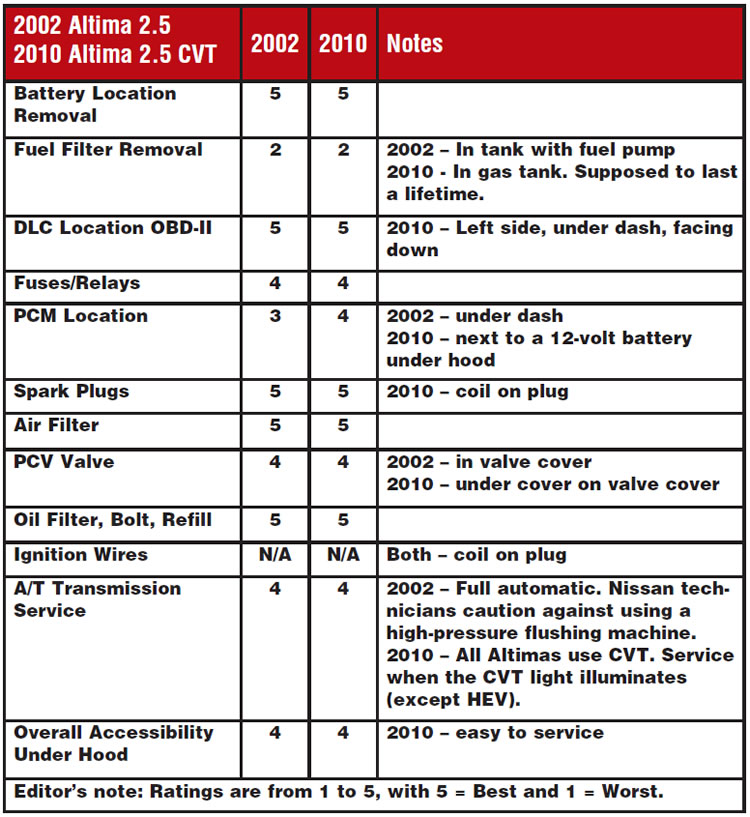
Tech to Tech
- Subject: Serviceability Report
- Vehicle Application: Nissan Altima
- Essential Reading: Diagnostician, R & R
- Author: Craig Van Batenburg, AAM
Is Nissan turning over a new Leaf?
Nissan was at one time named Datsun, but that was a long time ago. I worked for a Datsun dealership in Worcester, Mass., where I still live. Nissan was taken over by Renault in the late ’90s. Carlos Ghosn was hired away from Michelin to work with Renault.
After some time in France, Ghosn was sent to Japan to help a struggling Nissan turn a profit. He did exactly that. When he joined the company, it was $20 billion in debt and only three of its 48 models were generating a profit. Ghosn promised to resign if the company did not reach profitability by the end of the year and claimed that Nissan would have no net debt by 2005.
He defied Japanese business etiquette, cut thousands of Nissan jobs, shut the first of five domestic plants and auctioned off prized assets such as Nissan’s aerospace unit. In one year, Nissan’s net profit climbed to $2.7 billion from a loss of $6.1 billion in the previous year.
I had a chance to ask a question of Ghosn in New York, N.Y., at an International Motor Press Association event a couple of years ago. My question was, “Is Nissan going to produce its own hybrid technology?”
His answer was noncommittal. He said, “Nissan is still looking at hybrids but we have not decided at this time.”
That was in 2008. You most likely know by now that the new Nissan Leaf will be built and sold in the United States.
What is a Leaf? It is an all-electric vehicle (EV). That was the answer to my question to Ghosn – bypass hybrids with EVs.
That is a look back and into the future, but what about today?
This series of articles attempts to answer a simple question: “Did car designers consider technicians’ jobs when they drew up the plans?” This month, we will put the Nissan Altima to the test. We will compare the four-cylinder 2002 Altima to a 2010 model with a similar drivetrain.
Altima History
In 1993, Nissan discontinued its much-criticized Stanza, replacing it with the U.S.-made Altima, which, like the Stanza, is a compact car. The very first Altima rolled off the assembly line June 15, 1992, as a 1993 model. All Altimas were built in Smyrna, Tenn., until June 2004, when Nissan’s Canton, Miss., plant began producing additional Altimas to meet high demand.

As the years have rolled on, the Altima has been redesigned three times. The first generation was model year (MY) 1993-1997. There was an updated version in MY 1998-2001, a third generation in 2002-2006 and then, in 2007, it was overhauled once more. So, did the redesigns help us or hurt us in the service bays? Again, we seek out the answers about serviceability.
2002 Altima
In the 2002 Altima there were two engines: a DOHC 16-valve in-line four and a DOHC 24-valve V-6. The four-cylinder engine increased in capacity from 2.4 to 2.5 liters and was essentially a new unit that also had variable valve timing. Power and torque had risen from 155 horsepower and 156 lb.-ft. to 180 horses and 181 lb.-ft., comfortably exceeding both the 2002 Toyota Camry and Honda Accord.
A five-speed manual transmission was standard, but most customers bought the four-speed automatic.
Identifix reported that the four-cylinder model had occasional failures of the crankshaft-position (CKP) and camshaft-position (CMP) sensors and screws falling out of the intake-manifold power valve on the 2.5-liter engine.
Failure of the CKP or CMP sensor caused the engine to stall and the check engine light to illuminate. When the intake-manifold power-valve screws fall out, they enter the engine through the intake manifold and damage the spark plugs and sometimes the engine block. In some instances, problems with the engine sensors and intake-manifold power-valve screws may be covered by a factory recall. Not a good report if the engine is important to you. Most consumers, after 80,000 miles, were none too happy with this model.
In 2002, Van Batenburg’s Garage (VBG) Inc. was still in business and servicing all Asian brands. The technicians who worked at VBG were Honda and Toyota specialists and very good at preventing problems or fixing those we couldn’t prevent as long as the owners brought their cars in when we asked them to. We had a high success rate of keeping their cars safe, reliable and clean.
But if they owned a Nissan, that was another story. The technicians kept a bottle of Stabilant 22a handy, as poor electrical connections were common and after only a few years in New England there were corroded connectors and broken wires that caused a multitude of problems.
The only Nissan product I ever owned was a 2003 Ford/Nissan-built Mercury Villager. It was a V-6 minivan (family time at the Van Batenburg’s house) that served us for many years. Before it was put into service, we removed every connector we could access and visually inspected, wiggled, cleaned and added Stabilant 22a to each pin. Then we plugged it back in and added lithium grease around it. That process worked well. We also replaced any pins or receptacles in the connector that were questionable.
Honda and Toyota typically lube their connectors internally and install small O-rings on each wire to keep out moisture and chemicals. This was a common problem on Nissans that was also completely preventable.
In 2002, the Altima also suffered from poor wiring. Leaking head gaskets and the airbags, exhaust, fuel system, headlights, cam and crank sensors were all involved with recalls. This was not Nissan’s greatest achievement. Have things improved?

2010 Altima
Leading up to the 2010 model, the 2007-08 Altima had airbag problems again that resulted in a recall. Intermittently setting codes (P0335 and P0725), more crankshaft- and camshaft-sensor problems or possible wiring issues were still present. Nissan was not timely in solving known problem areas.
In 2010, all Altimas come with a continuously variable transmission (CVT). This CVT has a “manual mode” in all but the hybrid model (sold in only the seven green states). The 2.5-liter four-cylinder engine in the Altima makes 170 horsepower and 175 lb.-ft of torque. The car earns a PZEV (Partial Zero Emission Vehicle) rating, meaning there are very few smog-causing pollutants. Another bonus is the mileage, rated at 23 mpg city and 32 mpg highway by the EPA. The engine doesn’t seem powerful from the specifications, but the CVT makes good use of it.
A CVT doesn’t have fixed gears, instead relying on a steel belt and two pulleys to produce an infinite number of ratios. Nissan programmed the CVT to use the correct range of ratios depending on engine speed, throttle input and other data.
The Nissan Altima hybrid has a different type of CVT from the other models. This CVT uses two high-voltage AC motors spinning the sun and ring gears of a planetary gear set, with the internal-combustion engine (ICE) powering the planet carrier. If this sounds like the Toyota- or Ford-type CVT, it should – because Toyota supplies the hybrid powertrain from its Camry HEV (hybrid electric vehicle). The hybrid version sells well but only in seven states that have joined with California on a strict pollution program for cars. It is in limited production.
What do technicians say about the Altima? Flat-rate technicians love them, as they can earn a good paycheck with a diet of these cars. No one hates them, but this is not a car that is highly recommended. The newer version is not all that different from the previous model, just better looking. If Nissan is going to be a real leader in EV, then they better make their electrical system much more reliable and turn over a new “leaf.”
2002
- Ups – Lots to service and repair.
- Downs – Customers may stop the preventive maintenance because the car will cost them more to repair than others.
2010
- Ups – Selling well. Easy to service.
- Downs – Quality is still a question for long-term customer retention.

Craig Van Batenburg, AAM, is the owner of the Automotive Career Development Center (ACDC), www.auto-careers.org, and delivers management and technical seminars nationwide. He formerly owned Van Batenburg’s Garage Inc. in Worcester, Mass., for more than 25 years. Van Batenburg is ASE master and L1 certified, with advanced skills in hybrid drive systems. You can reach him by e-mail at [email protected].
This copyrighted article is reprinted with the permission of AutoInc., the official publication of the Automotive Service Association (ASA). To learn more about ASA and its commitment to independent automotive-service and repair professionals, visit www.ASAshop.org or call 800-272-7467.













